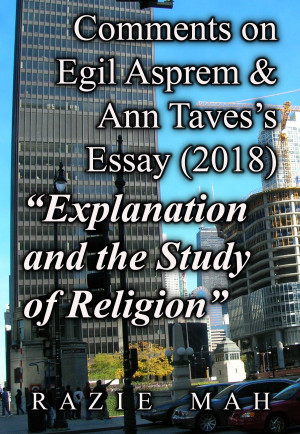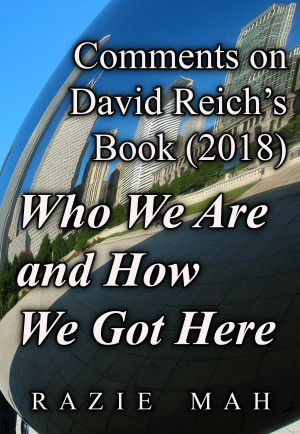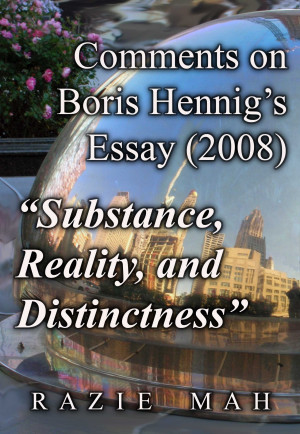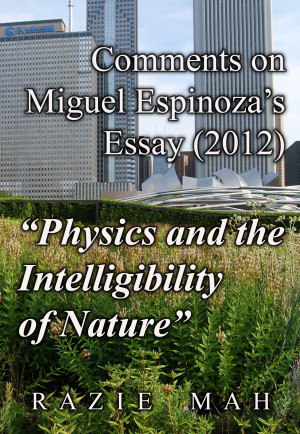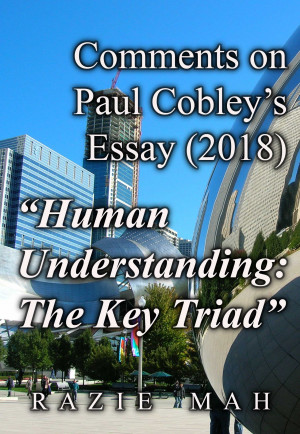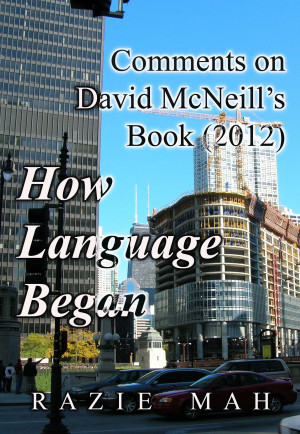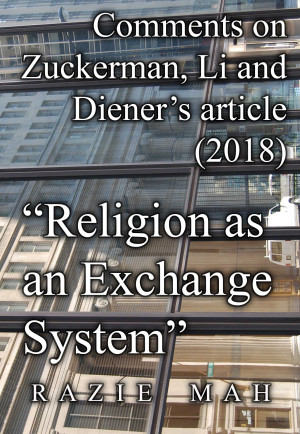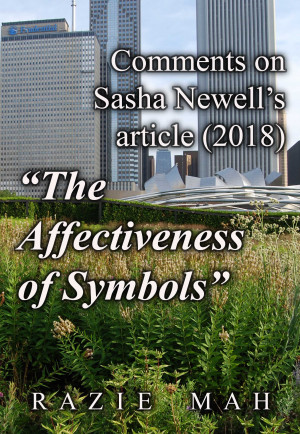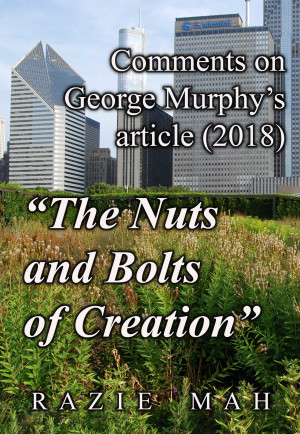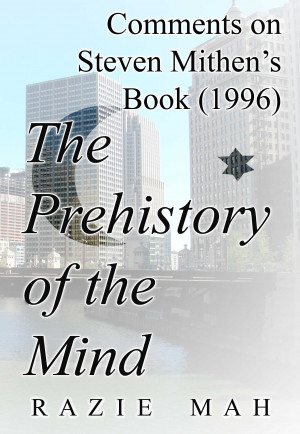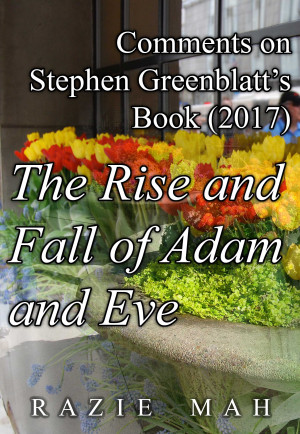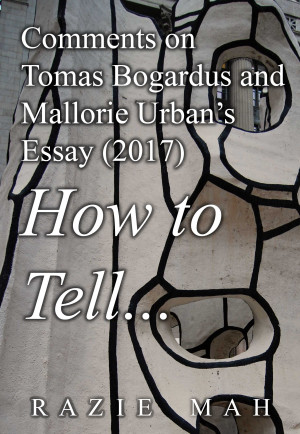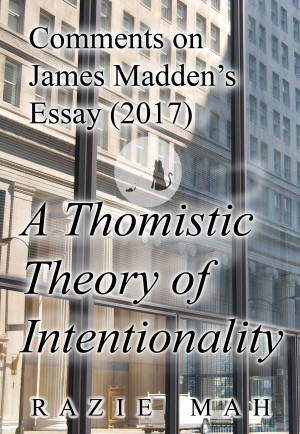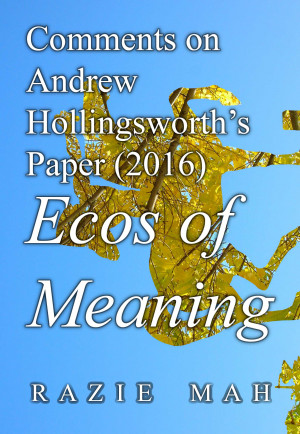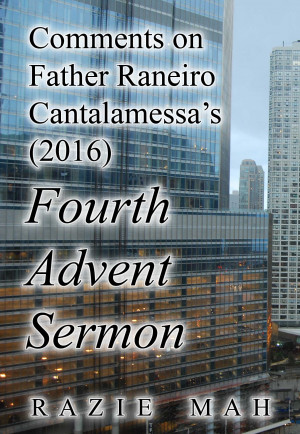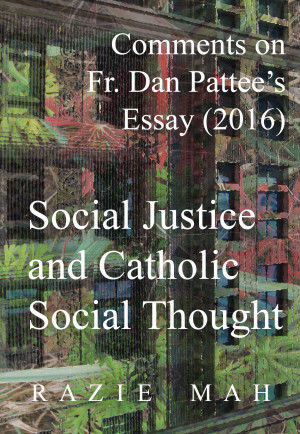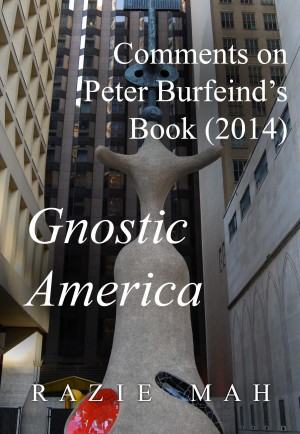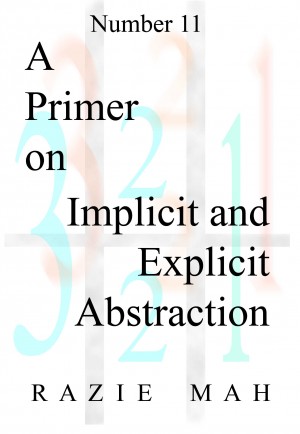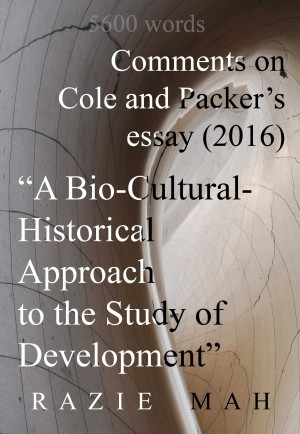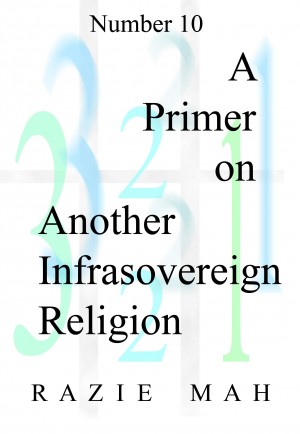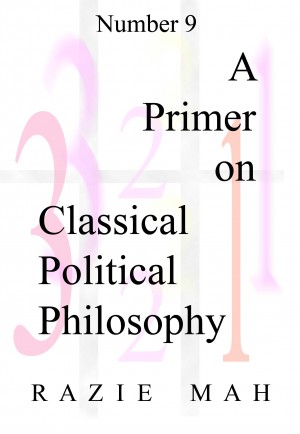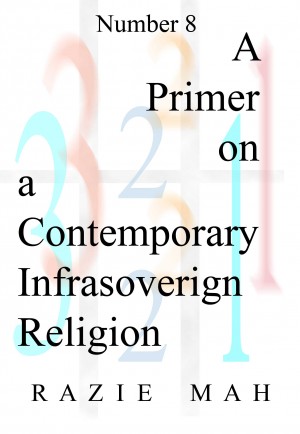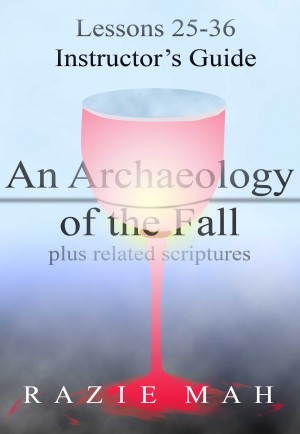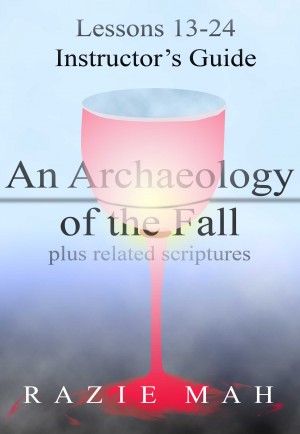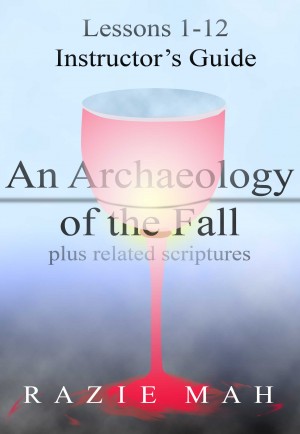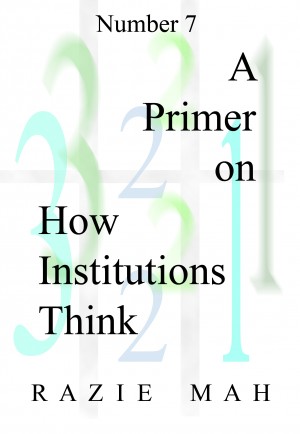Location: United States
Member Since:
Dec. 06, 2014
3 readers have added this author as a 'Favorite Author'.
Razie Mah
Biography
See website for bio.
Smashwords Interview
Where to find Razie Mah online
Where to buy in print
Books
Comments on Carlos Blanco-Perez's Essay (2018) "On the Principles of a Social Theory"
by Razie Mah
Series: A Course on Implicit and Explicit Abstraction · Empirio-schematics.
Price:
$2.15 USD.
Words: 6,130.
Language:
English.
Published: December 8, 2018
.
Categories:
Nonfiction » Social Science » Anthropology, Nonfiction » Philosophy » Social
Carlos Blanco-Perez publishes an essay in the October 2018 issue of Cadmus. He identifies ten postulates essential for a viable social theory. Ironically, the word "essential" serves as a pivotal starting point for constructing a feedback loop that satisfies the 10 principles. The resulting model should prove useful for appreciating the nature of social theory.
Comments on Egil Asprem and Ann Taves’s Essay (2018) "Explanation and the Study of Religion"
by Razie Mah
Series: Empirio-schematics.
Price:
$2.00 USD.
Words: 4,840.
Language:
English.
Published: November 10, 2018
.
Categories:
Nonfiction » Social Science » Anthropology, Nonfiction » Religion & Spirituality » Religion & Science
In 2018, Egil Asprem, at Stockholm University and Ann Taves, at University of California at Santa Barbara, publish the essay “Explanation and the Study of Religion”. My comments examine this article using models developed in comments on Wayne Proudfoot’s book, Religious Experience, and Jacques Maritain’s book, Natural Philosophy.
Comments on David Reich's Book (2018) Who We Are and How We Got Here
by Razie Mah
Series: Buttressing the Human Niche.
Price:
$2.25 USD.
Words: 6,030.
Language:
English.
Published: October 27, 2018
.
Categories:
Nonfiction » Science & Nature » Evolution, Nonfiction » Social Science » Anthropology
David Reich, Harvard geneticist, updates the vision of Luca Cavalli-Sforza, who first explored the idea that our genetics may provide insight into human evolution and prehistory. The techniques for DNA sequencing and mathematical modeling substantially improved over the past decades. These comments examine Reich's update through the lens of the hypotheses of the human niche and first singularity.
Comments on Boris Hennig's Essay (2008) "Substance, Reality and Distinctness"
by Razie Mah
Series: Peirce's Secondness and Aristotle's Hylomorphism.
Price:
$1.80 USD.
Words: 4,910.
Language:
English.
Published: September 2, 2018
.
Categories:
Nonfiction » Philosophy » European philosophy, Nonfiction » Philosophy » Religious philosophy
Boris Hennig, at Humbolt University in Berlin, writes about Descartes' view of substance. Descartes emphasizes distinctness and realness. Descartes applies the concept to God. These comments follow Hennig's argument in order to show how Descartes alters the word-scape of medieval scholasticism and sets the stage for empirio-schematic judgment.
Comments on Miguel Espinoza's Essay (2012) "Physics and the Intelligibility of Nature"
by Razie Mah
Series: Peirce's Secondness and Aristotle's Hylomorphism.
Price:
$2.00 USD.
Words: 3,750.
Language:
English.
Published: August 12, 2018
.
Categories:
Nonfiction » Science & Nature » Philosophy of Science, Nonfiction » Philosophy » Criticism
Miguel Espinoza, French philosopher, publishes his essay in Teorema (vol 31(1) pp 75-97), critiquing the arguments of Emile Meyerson (1854-1933), a contemporary of neo-Thomist Jacques Maritain. My comments re-articulate this article using models of empirio-schematic and Positivist judgment.
Comments on Jeremy Cohen's Essay (1980) "Original Sin as The Evil Inclination"
by Razie Mah
Series: Reverberations of the Fall.
Price:
$2.00 USD.
Words: 4,520.
Language:
English.
Published: August 11, 2018
.
Categories:
Nonfiction » Religion & Spirituality » Christian Theology / Apologetics, Nonfiction » Religion & Spirituality » Judaism / Theology
Jeremy Cohen, writing at Cornell University, publishes his essay in the Harvard Theological Review (vol 73(3/4) pp 495-520). He raises three concentric questions, leading to a comparison of Christian doctrine of original sin and the Jewish concept of the evil inclination. My comments examine this article using the category-based nested form and the first singularity.
Comments on Paul Cobley's Essay (2018) "Human Understanding: A Key Triad"
by Razie Mah
Series: Considerations of Jacques Maritain, John Deely and Thomistic Approaches to the Questions of These Times · Peirce's Secondness and Aristotle's Hylomorphism.
Price:
$2.00 USD.
Words: 3,600.
Language:
English.
Published: August 5, 2018
.
Categories:
Nonfiction » Philosophy » Epistemology, Nonfiction » Literary criticism » Semiotics & Theory
Paul Cobley, at Middlsex University, composes a remembrance for John Deely, by reviewing one of many innovative notions. These comments re-articulate this article using the category-based nested form. Deely's triad consists of actualities in an interscope.
Comments on David McNeill's Book (2012) How Language Began
by Razie Mah
Series: Buttressing the Human Niche.
Price:
$2.99 USD.
Words: 9,100.
Language:
English.
Published: July 8, 2018
.
Categories:
Nonfiction » Science & Nature » Evolution, Nonfiction » Philosophy » Language
David McNeill, Professor at the University of Chicago, has been publishing books on the unity of speech and gesture, starting in 1992 with the book: Hand and Mind. He approaches the evolution of talk from the view of the U of C's language lab. Why do people gesture when they speak? Is this an evolved trait? These comments re-articulate McNeill's work using the category-based nested form.
Comments on Zuckerman, Li and Diener's Article (2018) "Religion as an Exchange System"
by Razie Mah
Series: Empirio-schematics.
Price:
$2.25 USD.
Words: 10,460.
Language:
English.
Published: July 4, 2018
.
Categories:
Nonfiction » Social Science » Sociology, Nonfiction » Education & Study Guides » Home schooling
Miron Zuckerman, Chen Li and Ed Diener publish "Religion as An Exchange System: The Interchangeability of God and Government in a Provider Role" in The Personality and Social Psychology Bulletin. I re-articulate this work using category-based models of Darwinian evolution and empirio-schematic inquiry.
Comments on Jacques Maritain's Book (1935) Philosophy of Nature
by Razie Mah
Series: Considerations of Jacques Maritain, John Deely and Thomistic Approaches to the Questions of These Times · Empirio-schematics.
Price:
$2.99 USD.
Words: 19,310.
Language:
English.
Published: July 1, 2018
.
Categories:
Nonfiction » Science & Nature » Philosophy of Science, Nonfiction » Religion & Spirituality » Religion & Science
Jacques Maritain, bless his soul, strove to recover a scholastic philosophy of nature at the apex of modernism. How is a philosophy of nature related to science, on the one hand, and metaphysics, on the other? These comments re-articulate and explore Maritain's work using a model of judgment as a triadic relation, plus the category-based nested form.
Comments on Sasha Newell's Article (2018) "The Affectiveness of Symbols"
by Razie Mah
Series: Re-Articulations.
Price:
$1.80 USD.
Words: 6,510.
Language:
English.
Published: April 8, 2018
.
Categories:
Nonfiction » Social Science » Anthropology, Nonfiction » Science & Nature » Anthropology
In the February 2018 issue of Current Anthropology, Sasha Newell, a Professor in Brussels, Belgium, publishes an essay with the subtitle, "Materiality, Magicality, and the Limits of the Antisemiotic Turn". These comments re-articulate Newell's argument using models based on the category-based nested form. In the process, the interventional sign is discovered.
Comments on George Murphy's Article (2018) "The Nuts and Bolts of Creation"
by Razie Mah
Series: Reverberations of the Fall.
Price:
$1.80 USD.
Words: 6,140.
Language:
English.
Published: April 7, 2018
.
Categories:
Nonfiction » Religion & Spirituality » Religion & Science, Nonfiction » Philosophy » Religious philosophy
Rev. George Murphy, M.Div. and Ph.D. (Physics), investigates resonances between the Christian doctrine of creation and scientific knowledge. He has done so for 40 years. These comments re-articulate his argument using a category-based model of "the object that brings all into relation", expressed in the highest level of the society tier, for the presence underlying the word "religion".
Speculations on Thomism and Evolution
by Razie Mah
Series: Reverberations of the Fall · A Course on Evolution and Thomism.
Price:
$1.80 USD.
Words: 4,930.
Language:
English.
Published: April 5, 2018
.
Categories:
Nonfiction » Philosophy » Religious philosophy, Nonfiction » Religion & Spirituality » Religion & Science
Michael Chaberek, O.P., publishes a book titled Aquinas and Evolution (2017). The next year, Nicanor Austriaco, O.P., responds in the Witherspoon Institute's Public Discourse Forum, defending "Thomistic Evolution". This essay re-articulates the concepts in this defense, relying of the category-based nested form. In the end, living forms are rendered as mysteries compatible with the Word.
Comments on Cheong Lee's Essay (2018) "Peirce's Theory of Interpretation"
by Razie Mah
Series: Re-Articulations.
Price:
$1.50 USD.
Words: 3,110.
Language:
English.
Published: March 17, 2018
.
Categories:
Nonfiction » Philosophy » Aesthetics, Nonfiction » Philosophy » Movements / Pragmatism
Cheong Lee publishes his essay in Conteporary Pragmatism (15(1):1-14). The author explores Peirce's theory of interpretation, touching base with several modern semioticians along the way. These comments examine the argument backwards, using the category-based nested form. Interpretation informs aesthetics.
The Human Niche
by Razie Mah
Series: A Course on The Human Niche.
Price:
$4.99 USD.
Words: 14,210.
Language:
English.
Published: February 6, 2018
.
Categories:
Nonfiction » Science & Nature » Evolution, Nonfiction » Education & Study Guides » Home schooling
What is an adaptation? What is a niche? The category-based nested form turns out to be useful in relating the two. An adaptation exploits a niche. A niche is the potential of an actuality independent of the adapting species. What is the human niche? What is the potential, independent of the hominins, that sculpts humanity through many generations. Here is a scientific hypothesis.
Comments on Derek Bickerton's Book (2014) More than Nature Needs
by Razie Mah
Series: A Course on The Human Niche.
Price:
$2.99 USD.
Words: 7,490.
Language:
English.
Published: February 4, 2018
.
Categories:
Nonfiction » Science & Nature » Evolution, Nonfiction » Education & Study Guides » Home schooling
These comments address a 2014 book by a linguist, Derek Bickerton, on the evolution of language and mind. My goal is to re-articulate the author's arguments using the category-based nested form and the first singularity.
Comments on Robert Berwick and Noam Chomsky's Book (2016) Why Only Us?
by Razie Mah
Series: A Course on The Human Niche.
Price:
$2.99 USD.
Words: 7,490.
Language:
English.
Published: February 4, 2018
.
Categories:
Nonfiction » Science & Nature » Evolution, Nonfiction » Education & Study Guides » Home schooling
Robert Berwick and Noam Chomsky's book, Why Only Us?, is subtitled: Language and Evolution. This collection of essays addresses the evolution of language from the point of view of computational systems and generative grammar, the expertise of each author respectively. These comments offer a category-based alternative.
A Primer on Natural Signs
by Razie Mah
Series: A Course on The Human Niche.
Price:
$2.99 USD.
Words: 6,740.
Language:
English.
Published: February 3, 2018
.
Categories:
Nonfiction » Social Science » Sociology, Nonfiction » Education & Study Guides » Home schooling
Signs are triadic relations. Natural signs vary on the basis of the qualities of their sign-object. Icons are based on similarity. Indexes are founded on pointing. Symbols are built on convention. Each of these sign-qualities comes into play in the evolution of human language and religion. So, an understanding of natural signs is crucial for the postmodern human sciences.
Comments on Steven Mithen's Book (1996) The Prehistory of The Mind
by Razie Mah
Series: A Course on The Human Niche.
Price:
$2.99 USD.
Words: 6,680.
Language:
English.
Published: February 3, 2018
.
Categories:
Nonfiction » Science & Nature » Evolution, Nonfiction » Education & Study Guides » Home schooling
These comments address a book by an archaeologist, Steven Mithen, about human evolution. Mithen presents two evocative analogies for the mental evolution of hominins. The first is a play in four acts. The second is the historical evolution of church architecture. This work comments using the special vocabulary of the category-based nested form. The human niche is proposed.
Comments on Clive Gamble, John Gowlett and Robin Dunbar’s Book (2014) Thinking Big
by Razie Mah
Series: A Course on The Human Niche.
Price:
$2.99 USD.
Words: 10,270.
Language:
English.
Published: January 4, 2018
.
Categories:
Nonfiction » Science & Nature » Evolution, Nonfiction » Education & Study Guides » Home schooling
These comments address a 2014 book by three British researchers, on the evolution of language and mind. The subtitle is: How the Evolution of Social Live Shaped the Human Mind. My goal is to re-articulate their arguments using the category-based nested form and the first singularity.
Comments on Stephen Greenblatt’s Book (2017) The Rise and Fall of Adam and Eve
by Razie Mah
Series: Reverberations of the Fall.
Price:
$1.80 USD.
Words: 5,820.
Language:
English.
Published: November 21, 2017
.
Categories:
Nonfiction » Religion & Spirituality » Biblical Meditations / General, Nonfiction » Philosophy » Religious philosophy
This work comments on a book written by Stephen Greenblatt under the title, The Rise and Fall of Adam and Eve, published by W.W. Norton Press. My goal is to examine this work from the perspective of the First Singularity. The hypothesis of the First Singularity addresses the question: Why is our current Lebenswelt not the same as the Lebenswelt that we evolved in?
Comments on James V. Schall S.J.’s (2017) Political Philosophy and Catholicism
by Razie Mah
Series: Intimations of Political Philosophy.
Price:
$1.80 USD.
Words: 2,890.
Language:
English.
Published: October 15, 2017
.
Categories:
Nonfiction » Philosophy » Political, Nonfiction » Philosophy » Methodology
This essay comments on a short article appearing in The Catholic Social Science Review (vol. 22, 2017, pages 147-156). The goal is to re-articulate the argument using the primal triad of judgment and the category based nested form.
Comments on Dennis Venema and Scot McKnight’s Book (2017) Adam and the Genome
by Razie Mah
Series: Reverberations of the Fall · A Course on Evolution and Thomism.
Price:
$2.40 USD.
Words: 9,330.
Language:
English.
Published: June 24, 2017
.
Categories:
Nonfiction » Religion & Spirituality » Christian Theology / Anthropology, Nonfiction » Religion & Spirituality » Religion & Science
These comments address a book by geneticist, Dennis Venema, and theologian, Scot McKnight. Venema establishes that Adam and Eve cannot be the actual parents of all humans. McKnight establishes the stories of Adam and Eve are written in styles and themes of ancient Near East literature. My goal is to re-articulate their arguments using the category-based nested form and the first singularity.
Comments on Daniel Novotny’s Essay (2017) Izquierdo on Universals
by Razie Mah
Series: Considerations of Jacques Maritain, John Deely and Thomistic Approaches to the Questions of These Times.
Price:
$1.60 USD.
Words: 3,700.
Language:
English.
Published: May 20, 2017
.
Categories:
Nonfiction » Religion & Spirituality » Christian Theology / Anthropology, Nonfiction » Religion & Spirituality » Psychology of Religion
Disputation 17 of the Baroque scholastic treatise The Lighthouse of the Sciences (1659) covers the topic of universals. Sebastian Izquierdo wrote the treatise. Daniel Novotny published a summary in the Spring 2017 issue of the American Catholic Philosophical Quarterly. My comments demonstrate the postmodern relevance of this topic, using the category-based nested form.
Comments on Tomas Bogardus and Mallorie Urban’s Essay (2017) How to Tell...
by Razie Mah
Series: Re-Articulations.
Price:
$1.80 USD.
Words: 4,960.
Language:
English.
Published: May 14, 2017
.
Categories:
Nonfiction » Religion & Spirituality » Comparative Religion, Nonfiction » Religion & Spirituality » Theology
This work comments on an essay published by Tomas Bogardus and Mallorie Urban in the Spring 2017 edition of Faith and Philosophy: Journal of the Society of Christian Philosophers (volume 34(2), pages 176-200), under the title, “How to Tell Whether Christians and Muslims Worship the Same God”. My goal is to re-articulate this work in the specialized language of the category-based nested form.
Comments on Joshua Lee Harris’s Essay (2017) Analogy in Aquinas
by Razie Mah
Series: Considerations of Jacques Maritain, John Deely and Thomistic Approaches to the Questions of These Times.
Price:
$1.60 USD.
Words: 4,810.
Language:
English.
Published: April 29, 2017
.
Categories:
Nonfiction » Religion & Spirituality » Christian Theology / General, Nonfiction » Philosophy » Religious philosophy
This work comments on an essay published by Joshua Lee Harris in the January 2017 edition of Faith and Philosophy: Journal of the Society of Christian Philosophers (volume 34(1), pages 33-56), under the title, “Analogy in Aquinas: The Alston-Wolterstorff Debate Revisited”. My goal is to re-articulate Harris’s work in the specialized language of the category-based nested form.
Comments on James Madden’s Essay (2017) A Thomistic Theory of Intentionality
by Razie Mah
Series: Considerations of Jacques Maritain, John Deely and Thomistic Approaches to the Questions of These Times.
Price:
$1.70 USD.
Words: 4,680.
Language:
English.
Published: April 8, 2017
.
Categories:
Nonfiction » Religion & Spirituality » Christian Theology / Anthropology, Nonfiction » Philosophy » Metaphysics
This work comments on an essay by James D. Madden published in the Winter 2017 edition of The American Catholic Quarterly. The essay is titled, “Is a Thomistic Theory of Intentionality Consistent with Physicalism?” My goal is to re-articulate the argument in the specialized language of the category-based nested form.
Comments on Andrew Hollingsworth’s Paper (2016) Ecos of Meaning
by Razie Mah
Series: Considerations of Jacques Maritain, John Deely and Thomistic Approaches to the Questions of These Times.
Price:
$1.50 USD.
Words: 4,400.
Language:
English.
Published: February 18, 2017
.
Categories:
Nonfiction » Religion & Spirituality » Biblical Studies / Exegesis & Hermeneutics, Nonfiction » Philosophy » Language
This essay comments on Andrew Hollingworth’s presentation at the annual meeting of the Evangelical Theological Society (2016) in San Antonio. His paper is subtitled Umberto Eco’s Semiotic Theory for Theological Hermeneutics. The category-based nested form is used to model features of Umberto Eco’s semiotic theory. These models are applied to an example.
Comments on Father Reniero Cantalamessa’s (2016) Fourth Advent Sermon
by Razie Mah
Series: Re-Articulations.
Price:
$1.50 USD.
Words: 4,550.
Language:
English.
Published: February 11, 2017
.
Categories:
Nonfiction » Religion & Spirituality » Christian Theology / Anthropology, Nonfiction » Religion & Spirituality » Religion & Science
This essay comments on Father Raniero Cantalamessa’s advent sermon for the Pontifical Household. The lecture is on the nature of Mary in regards to Christmas. My goal is to re-articulate the argument in the specialized language of the category-based nested form.
Comments on George Weigel’s Book (2007) Faith, Reason and the War against Jihadism
by Razie Mah
Series: Intimations of Political Philosophy.
Price:
$2.99 USD.
Words: 19,140.
Language:
English.
Published: January 15, 2017
.
Categories:
Nonfiction » Philosophy » Religious philosophy, Nonfiction » Religion & Spirituality » Theology
This 19,200 word essay comments on George Weigel’s book, published at the end of the administration of President George Bush. The category-based nested form lays out relational structures. Theology runs beneath the surface of Weigel’s 15 lessons.
Comments on Thomas Hobbes Book (1651) The Leviathan Part 4
by Razie Mah
Series: Comments on Thomas Hobbes Book (1651) The Leviathan Parts 1-4.
Price:
$2.99 USD.
Words: 10,900.
Language:
English.
Published: November 25, 2016
.
Categories:
Nonfiction » Social Science » Sociology, Nonfiction » Education & Study Guides » Home schooling
This 10,900 word comment applies the category-based nested forms to Hobbes’ ideas. In Part 3, Hobbes details his ideas on the Christian commonwealth. Christians are empowered to counsel the sovereign, nothing more. In Part 4, Hobbes combats other ideas about the relation between religion and politics.
Comments on Thomas Hobbes Book (1651) The Leviathan Part 3
by Razie Mah
Series: Comments on Thomas Hobbes Book (1651) The Leviathan Parts 1-4.
Price:
$2.99 USD.
Words: 16,570.
Language:
English.
Published: November 25, 2016
.
Categories:
Nonfiction » Social Science » Sociology, Nonfiction » Education & Study Guides » Home schooling
This 16,600 word comment applies the category-based nested forms to Hobbes’ ideas. In Part 3, Hobbes turns to scripture in order to confirm his model of the subject and the commonwealth. The category-based nested form is used to show the relations within his models.
Comments on Thomas Hobbes Book (1651) The Leviathan Part 2
by Razie Mah
Series: Comments on Thomas Hobbes Book (1651) The Leviathan Parts 1-4.
Price:
$2.99 USD.
Words: 12,270.
Language:
English.
Published: November 25, 2016
.
Categories:
Nonfiction » Social Science » Sociology, Nonfiction » Education & Study Guides » Home schooling
This 12,300 word comment applies the category-based nested forms to Hobbes’ ideas. In the part on the commonwealth, the reader learns that the sovereign rules the subject based on 3 natural laws. Part 2 ends with a description of the civil state.
Comments on Thomas Hobbes Book (1651) The Leviathan Part 1
by Razie Mah
Series: Comments on Thomas Hobbes Book (1651) The Leviathan Parts 1-4.
Price:
$2.99 USD.
Words: 16,110.
Language:
English.
Published: November 25, 2016
.
Categories:
Nonfiction » Social Science » Sociology, Nonfiction » Education & Study Guides » Home schooling
This 16,200 word comment applies the category-based nested forms to Hobbes’ ideas. How does Hobbes depict the difficult relations between subject and sovereign in the society tier? He portrays them as natural phenomena. Each person is an institution. The sovereign is the commonwealth. Three natural laws generate the commonwealth.
Comments on Fr. Dan Pattee’s Essay (2016) Social Justice and Catholic Social Thought
by Razie Mah
Series: Intimations of Political Philosophy.
Price:
$1.25 USD.
Words: 4,370.
Language:
English.
Published: November 19, 2016
.
Categories:
Nonfiction » Philosophy » Social, Nonfiction » Education & Study Guides » Essays
This 4400 word essay applies the category-based nested form to an essay by Fr. Dan Pattee, T.O.R., entitled “Social Justice and Catholic Social Thought”, appearing in The Catholic Social Science Review (volume 21, pages 99-115).
Comments on Eric Santner’s Book (2016) The Weight of All Flesh
by Razie Mah
Series: Intimations of Political Philosophy.
Price:
$2.99 USD.
Words: 23,620.
Language:
English.
Published: November 17, 2016
.
Categories:
Nonfiction » Philosophy » Political, Nonfiction » Education & Study Guides » Essays
This 23,700 word essay comments on Eric Santners’s book, subtitled On the Subject-Matter of Political Economy. The category-based nested form is used to model features of Santner’s directed associations. These models complement the text.
Comments on Peter Burfeind’s Book (2014) Gnostic America
by Razie Mah
Series: How to Define the Word "Gnosticism": A Short Course · Intimations of Political Philosophy.
Price:
$2.99 USD.
Words: 23,040.
Language:
English.
Published: August 15, 2016
.
Categories:
Nonfiction » Philosophy » Religious philosophy, Nonfiction » Education & Study Guides » Home schooling
This 23,100 word essay comments on Peter Burfeind’s book, concerning a resurgent Gnosticism in contemporary America. The category-based nested form is used to model the Gnostic origin myth. This model is then compared to other features of contemporary Gnosticism.
Comments on John Deely's Book (1994) New Beginnings
by Razie Mah
Series: A Course on Implicit and Explicit Abstraction · Considerations of Jacques Maritain, John Deely and Thomistic Approaches to the Questions of These Times · Peirce's Secondness and Aristotle's Hylomorphism.
Price:
$2.99 USD.
Words: 9,930.
Language:
English.
Published: July 16, 2016
.
Categories:
Nonfiction » Philosophy » Methodology, Nonfiction » Education & Study Guides » Home schooling
This 9,900 word essay comments on John Deely’s analysis of scholasticism of the Baroque Era. The category-based nested form is used to model arguments about the causality inherent in triadic signs. In particular, Suarez’s interscope for ens rationis applies.
A Primer on Implicit and Explicit Abstraction
by Razie Mah
Series: A Course on Implicit and Explicit Abstraction.
Price:
$2.99 USD.
Words: 10,720.
Language:
English.
Published: June 26, 2016
.
Categories:
Nonfiction » Philosophy » Logic, Nonfiction » Education & Study Guides » Home schooling
This 10,800 word essay builds on comments about Daniel Novotny’s study in scholasticism of the Baroque Era. The category-based nested form is used to model implicit and explicit abstraction. The first singularity comes into play.
Comments on Daniel Novotny’s Book (2013) Ens Rationis from Suarez to Caramuel
by Razie Mah
Series: A Course on Implicit and Explicit Abstraction · Considerations of Jacques Maritain, John Deely and Thomistic Approaches to the Questions of These Times.
Price:
$2.99 USD.
Words: 14,800.
Language:
English.
Published: April 23, 2016
.
Categories:
Nonfiction » Philosophy » Religious philosophy, Nonfiction » Education & Study Guides » Home schooling
This 14,800 word essay comments on Daniel Novotny’s study in scholasticism of the Baroque Era. The category-based nested form is used to model arguments about beings of reason (by Suarez, Hurtado, Mastri, Belluto and Caramuel). Implicit and explicit abstraction are modeled along the way.
Comments on Roger Teichmann’s Article (2016) The Identity of a Word
by Razie Mah
Series: Considerations of Jacques Maritain, John Deely and Thomistic Approaches to the Questions of These Times.
Price:
$1.25 USD.
Words: 3,010.
Language:
English.
Published: March 20, 2016
.
Categories:
Nonfiction » Philosophy » Language, Nonfiction » Education & Study Guides » Essays
This 3100 word essay comments on an article appearing in the winter 2016 issue of The American Catholic Philosophical Quarterly (Volume 90). The article is titled, The Identity of a Word. The author of the article is Roger Teichmann, a professor at St. Hilda’s College, University of Oxford in Oxford, United Kingdom.
Comments on “A Bio-Cultural-Historical Approach to the Study of Development (2016)”
by Razie Mah
Series: Re-Articulations.
Price:
$1.99 USD.
Words: 5,310.
Language:
English.
Published: November 27, 2015
.
Categories:
Nonfiction » Psychology » Developmental / general, Essay » Sociology
This 5600 word commentary summarizes, comments on, and re-articulates Michael Cole’s and Martin Packer’s essay “A Bio-Cultural Historical Approach to the Study of Development”, slated to appear in volume 6 of Handbook of Advances in Culture and Psychology, edited by M. J. Gelfand, C. Chui and Y. Hong.
A Primer on Another Infrasovereign Religion
by Razie Mah
Series: How to Define the Word "Religion" and Related Primers.
Price:
$2.99 USD.
Words: 5,710.
Language:
English.
Published: June 14, 2015
.
Categories:
Nonfiction » Social Science » Sociology, Nonfiction » Education & Study Guides » Home schooling
This primer is the tenth in a series on the category-based nested forms. A nested form model for “the presence underlying the word ‘religion’” may be constructed of three tiers of interscopes. The third tier is the society tier. In this primer, the entire society tier comes into view.
A Primer on Classical Political Philosophy
by Razie Mah
Series: How to Define the Word "Religion" and Related Primers.
Price:
$2.99 USD.
Words: 10,770.
Language:
English.
Published: June 14, 2015
.
Categories:
Nonfiction » Social Science » Sociology, Nonfiction » Education & Study Guides » Home schooling
This primer is the ninth in a series on the category-based nested forms. A nested form model for “the presence underlying the word ‘religion’” may be constructed of three tiers of interscopes. The third tier is the society tier. Institutions occupy the content level. The sovereign occupies the situation level. Classical political philosophy questions the situation. Is there a perspective?
A Primer on a Contemporary Infrasovereign Religion
by Razie Mah
Series: How to Define the Word "Religion" and Related Primers.
Price:
$2.99 USD.
Words: 10,070.
Language:
English.
Published: June 6, 2015
.
Categories:
Nonfiction » Social Science » Sociology, Nonfiction » Education & Study Guides » Home schooling
This primer is the eighth in a series on the category-based nested forms. A nested form model for “the presence underlying the word ‘religion’” may be constructed of three tiers of interscopes. The third tier is the society tier. Institutions occupy the content level. The sovereign occupies the situation level. Infrasovereign religions are “institutions that can grasp for sovereign power”.
Lessons 25-36 for Instructor’s Guide to An Archaeology of the Fall and Related Scriptures
by Razie Mah
Series: A Course of Study: An Archaeology of the Fall.
Price:
$2.99 USD.
Words: 27,180.
Language:
English.
Published: May 24, 2015
.
Categories:
Nonfiction » Education & Study Guides » Home schooling, Nonfiction » Social Science » Anthropology
This is the third of three sets of lessons for a course on this work and related scriptures.
Lessons 13-24 for Instructor’s Guide to An Archaeology of the Fall and Related Scriptures
by Razie Mah
Series: A Course of Study: An Archaeology of the Fall.
Price:
$2.99 USD.
Words: 24,770.
Language:
English.
Published: May 24, 2015
.
Categories:
Nonfiction » Education & Study Guides » Home schooling, Nonfiction » Social Science » Anthropology
This is the second of three sets of lessons for a course on this work and related scriptures. The course is suitable for high school and college students.
Lessons 1-12 for Instructor’s Guide to An Archaeology of the Fall and Related Scriptures
by Razie Mah
Series: A Course of Study: An Archaeology of the Fall.
Price:
$2.99 USD.
Words: 19,480.
Language:
English.
Published: May 24, 2015
.
Categories:
Nonfiction » Education & Study Guides » Home schooling, Nonfiction » Social Science » Anthropology
An Archaeology of the Fall is groundbreaking. This is the first of three sets of lessons for a course on this work and related scriptures. The course is suitable for high school and college students. The instructor’s guide offers programmatic questions (and answers) that should stimulate conversation. The questions flow from the structure category-based nested form.
Comments on Religious Experience (1985) by Wayne Proudfoot
by Razie Mah
Series: Re-Articulations.
Price:
$3.59 USD.
Words: 19,140.
Language:
English.
Published: May 13, 2015
.
Categories:
Nonfiction » Religion & Spirituality » Religion & Science, Nonfiction » Social Science » Anthropology
In 1986, Proudfoot won a book award for “Religious Experience” from the American Academy of Religion. The Professor of Religion at Columbia University critically examined the 180 year old claims of Friedrich Schleiermacher. This work examines Proudfoot’s writing through association with category-based nested forms. This work will interest anyone interested in the religious experience.
A Primer on How Institutions Think
by Razie Mah
Series: How to Define the Word "Religion" and Related Primers.
Price:
$2.99 USD.
Words: 9,990.
Language:
English.
Published: April 28, 2015
.
Categories:
Nonfiction » Social Science » Sociology, Nonfiction » Education & Study Guides » Home schooling
This primer is the seventh in a series on the category-based nested forms. A nested form model for “the presence underlying the word ‘religion’” may be constructed of three tiers. Each tier contains an interscope. The interscope for the third tier, the society tier, starts with the institution level. Mary Douglas’s book “How Institutions Think” is reviewed.
Razie Mah's tag cloud
abstraction
actuality
adam and eve
adaptation
aesthetics
affect
agamben
america
analogy
anscombe
anthropology
aquinas
archaeology
aristotle
art
augustine
baroque
behavior
being
bible
big government liberalism
brain
carl schmitt
category based nested form
catholic
catholicism
charles s peirce
christ
christian
christmas
civil state
civilization
cognitive psychology
commonwealth
concurrence
cooperation
creation
creole
culture
darwinism
deely
definition
descartes
dna
dunbar
emperioschematics
empirioschematics
empiroschematics
ens
environment
eric voegelin
esse
essence
evolution
evolution of talk
evolutionary psychology
exegesis
exemplar
existence
experience
explanation
first singularity
form
freud
genesis
genetics
george weigel
gesture
glory
gnostic
god
government
grammar
hand talk
heresy
hermeneutics
history
homosexual
human
human evolution
hylomorphism
immortality
infrasovereign religion
institution
institutions
intelligence
intentionality
interpellation
interpretation
interscope
interventional sign
islam
jeremy cohen
judgment
language
lebenswelt
leo strauss
literature
logic
maritain
martin packer
marx
mary
mary douglas
materialism
meaning
meyerson
michael cole
mind
modern
mother of god
muslim
nature
nested form
nicene creed
niche
nicholas wolterstorff
ontogeny
organization
original sin
origins
origins of man
paul
peirce
philosopher
philosophy
physicalism
piaget
pidgin
pierce
point
political philosophy
politics
pope benedict xvi
positivism
postmodern
power
proudfoot
providence
psychology
purity
quran
rationality
reductionism
reference
religion
rene girard
resurrection
robert bellarmine
saussure
schleiermacher
scholastic
scholasticism
science
security
semiology
semiotics
sign
sign language
signs
simplicity
social
social construction
social justice
social science
society
sociology
socrates
sovereign
specificative
speech
speech talk
suarez
substance
suprasovereign religion
sura 5
symbol
technical
teichmann
the evil inclination
theology
theory
thomas hobbes
thomism
triadic relation
triadic relations
triadic structure of judgment
trinity
umberto eco
understanding
universals
virtue
vygotsky
william alston
wittgenstein
word
words



